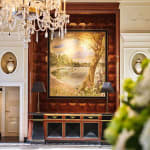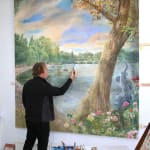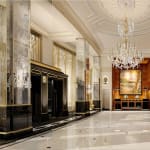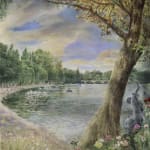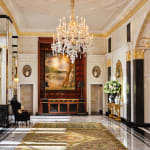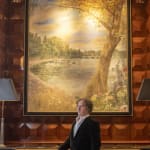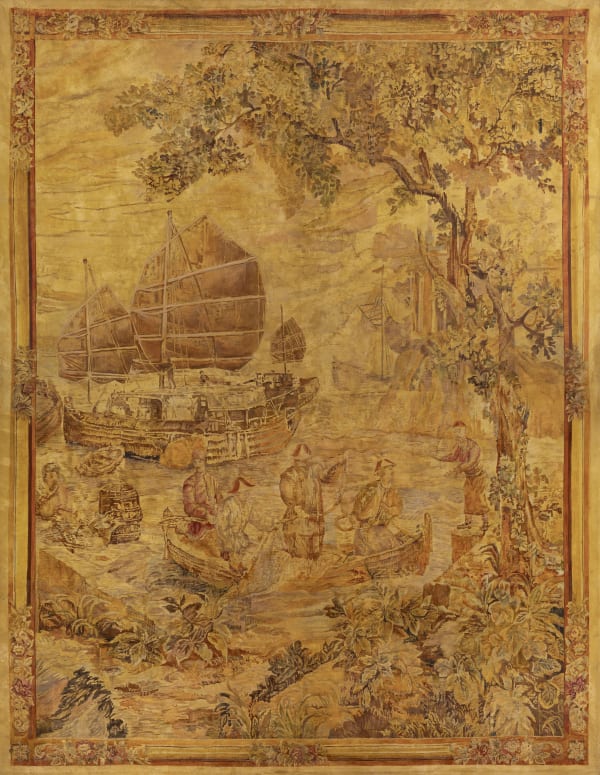

Christian Furr in his studio adding the finishing touches to the Serpentine painting for the Dorchester 2022


The Serpentine Painting 2022
Oil on Linen
270 x 230 cm
8 7/8 x 7 1/2 feet


The Daily Telegraph 23 January 2023
Lakeside : Christian Furr's painting of th eSerpentine hangs in the newly renovated Dorchester hotel. He was the youngest artist, age 28, to officially paint the late Queen.
PHOTO Heathcliff O'Malley/Daily Telegraph
Christian Furr
Further images
In 2022 The Dorchester, commissioned Christian Furr to create an imposing painting for their newly designed and refurbished lobby.
The 2.7 x 2.3m painting, featuring the Serpentine and Hyde Park, contains many themes and stories that celebrate the nature of the area.
Viewers are invited into a timeless scene of the edge of the Serpentine in Hyde Park, rendered at magnificent scale in oil paint.
Christian Furr brings together elements of nature, human activity and the seasons that span past, present and future, with numerous hidden elements to discover—lovers in the water, runners on the bank, rowers in the river, and the Serpentine Bridge in the distance.
The painting combines real and imagined elements that invoke a dreamlike atmosphere which is reminiscent of the spirit of J.M Barrie’s ‘Peter Pan’.
“Let me talk about intent.
'Music doesn’t illustrate emotion, so it is with paintings' - John Hoyland
I thought this could be something to have in my mind while working on this painting. What I am thinking or feeling over what I am seeing. As it would encompass so many elements, I wanted this painting to have the characteristics and quality of a dream or an imagining. It is I hope a combination of a powerful charge of visual, mental and emotional energy with some recourse to historical established figurative imagery.
A dream has it's own reality and while you are in the dream that is the normal reality. Some paintings are like entering someone else's dream. Sometimes dreams can be powerful and can have a lasting effect.
If you accept the idea of viewing a painting in a state of ‘daydream’ open to its effects then this symbolic dreamlike content becomes a powerful factor in influencing your feelings about the painting. Since your dreams can take you into areas which can never be a part of your conscious mind, I think a work of art can affect you in much the same way as a dream does.
Being the biggest painting I had done up to that date, it provided an opportunity for creating something different and apt for the setting where it would be seen and experienced.
I liked the idea of this painting being like an enchantment. Art can be a spell to enduce a state of enchantment in which consciousness is expanded and maybe this place exists outside of time like Proust's quote: "maintenant..il pouvait se trouver dans le seul milieu où il put vivre, jouir de l’essence des choses, c’est-a-dire en dehors du temps” - Proust
trans. "now...he could find himself in the only environment where he could live, enjoy the essence of things, that is to say outside of time.
I want people to respond to its effects without being conscious of how they have been achieved. I want the painting to leave an after-effect or feeling. I want people to experience the state of discovery that I was in when I painted it and when they see it for a second time, to find things they didn't see before.
I wanted it to appear as like a beatific window onto the preciousness of life on earth; an altar to our nature and a painting for all seasons - the season you are in is the season you notice first. There is a a lot of light and movement in it I hope. I wanted it to shimmer.
I wasn't sure what the painting would end up looking like. I had the sketch, ideas and verbal phrases and all the reference I could gather. Sometimes I felt like I was in uncharted territory. The result is an ordered struggle to create something that fit my vision of what it should be. Painting when there is not existing form to work from is almost an interior process.
The aim becomes making a reality visible instead of copying the visible. If I was to leave an area as it was, it was the result of prolonged interrogation of myself and my motivation.
In this way, even though it is a glimpsed pastoral scene, it was sometimes closer to the process of creating abstract art and sometimes like a sketch so that there is enough ambiguity that the viewer can finish areas themselves with their own imagination. Ultimately the result is a combination of reality and imagining (fantasy).
I knew I wanted the painting to encompass all the seasons. You seem to notice what season you are in when looking at it. The lower strata is vernal (Spring). Blossoming roses on the lower right as in the rose garden of Hyde Park then the wild flowers that exist in the park on the left, cornflowers and thistles. The middle strata is summer. The Serpentine itself with all the activities that take place on the water. Boating/ pedalos. Suggestions of people on the left bank, walking, enjoying the park and what it has to offer. The upper part of the painting is the overhanging golden leaves of the horse chestnut tree - framing the painting like an Autumnal cathedral roof. Slowly turning to winter in the top left.
Painting it was protean. I was moving my paints around the linen working on it in the hope of a revelation. So I painted it in a state of discovery. There are many elements within the painting for discovery. There is a leaf that is clearly painted on the tree. Red and gold. The idea is to remind you what a leaf is for. To fall. Like the song by Joseph Kosma. I have infused it with the air of Peter Pan. JM Barrie’s first iteration of Neverland was an island on the Serpentine. I want viewers to have the discoveries that I did making it. To find the goldfinch, to find the lovers, to find the lines of writing, to find the leaf and to find the bee.
I tried to arrange the composition so that the eye moves around it accordingly discovering new details each time. The eye leads from the foreground wild flowers then roses to the Pre-raphealite Alexander Munro statue of the buy and dolphin (which appears behind the rose garden), up the tree trunk then goes left across the bridge and up into the sky and branches and then down again to the left bank and the people in various activities here and on the water.
Compostionally I examined the natural stuctures and compostion lines evident in honeycomb structures in nature that look like inverted trapezoid shapes. I arranged the new composition accordingly, subliminally mirroring some of the natural diagonal composition ‘plates’ that occur in honeycomb structures. Consequently there is an overall and slightly unusual ‘V’ shape composition to the piece at first sight. Honeycomb has particular colours evident in it. With various different rich warm yellows varying from pale lemon sorbet colour to the dark brown of propolis. I have subtly infused these colours into the work.
I was thinking of this painting almost like a tapestry with the same colour threads going through it which unite it. For this reason, I tried something I haven't tried before. I abstracted the scene in seven areas and painted it in areas of flat colour. These became the base colour areas to react with and paint over.
The colours I began with, each contained the same base note colour so it has a feeling of being united. I wanted each part to relate to and resonate with the other and be part of the same harmonious 'fabric' - Initial inspiration - Vanessa Bell (of the Bloomsbury group)'s colour palette/ the simplicity and colour gradients of the Japanese tradition.
"The most interesting painting is one that expresses more of what one thinks than of what one sees" ~ Mark Rothko.
I was inspired by Shakespeare. I did my own version of the Chandos portrait which hung in my studio while I was painting the Serpentine painting. I had two phrases to work with ’An Allegory of love /All the seasons’ In the Tempest Shakespeare talks of 'Art to enchant' he also talks of the bee. I ended up writing a verse of my own inspired by Shakespeare which is written in the roses in the bottom right "Wherever the bee is, there I'll be."
Around the lake and on it are the impressions of people rendered in flecks of brushstrokes. On the Serpentine itself and the surface of the water there are people in activities enjoying the water. There's a myriad of cool and warm colours of complementary hues. I was particularly inspired by Monet andWatteau and his fetes gallantes
I visited Hyde Park many times in the morning and at twilight and took photographs: The lake / people on the banks/ activity on the water/ the bridge/ the rose garden/ the boy with dolphin statue/ the wild flowers. I got as much reference in different lights and times as I could. I visited the Dorchester Penthouse and pavillion and made mental notes of the colours, designs and motifs here and the baroque elegance and Oliver Messel's work. I used all this reference to make the painting respond and encapsulate everything.” – Christian Furr
Provenance
The Dorchester 2022Exhibitions
Permanent collection of the Dorchester - The Dorchester Collection
Literature
23 January 2023 - The painting is now on dispaly at the Dorchester
- X
- Tumblr
This website uses cookies
This site uses cookies to help make it more useful to you. Please contact us to find out more about our Cookie Policy.
